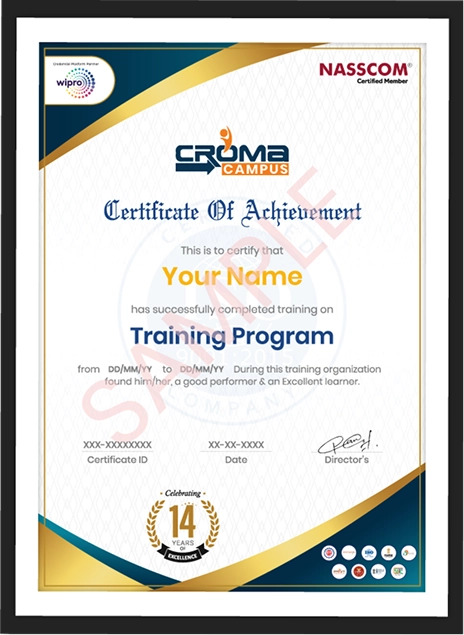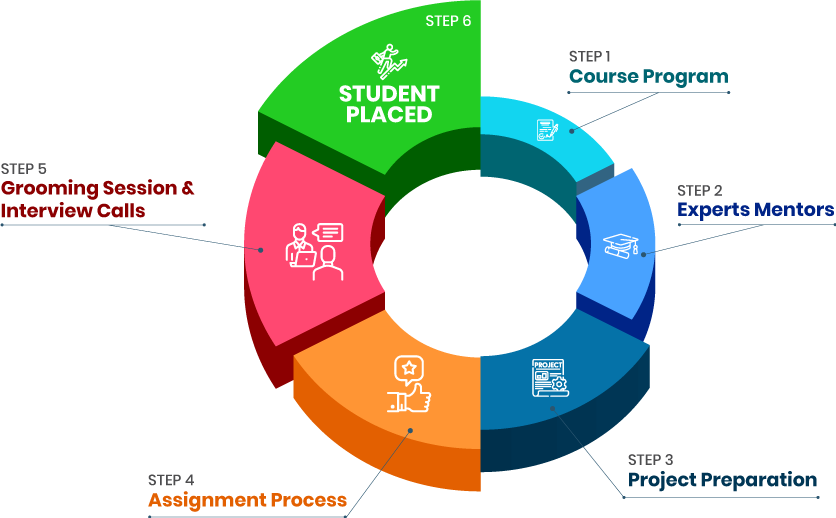- 2 Live Project
- Self-Paced/ Classroom
- Certification Pass Guaranteed
Course Offered By
You become a master in all the Java components and get an understanding of how to design and develop web apps from scratch making use of full stack technologies. You can either design single page app or multiple pages depending on your needs.
Using MEAN stack, you get an understanding of how to design more superior apps.
The course gives you a thorough understanding of different web development concepts such as plug-ins, JQUERY, AJAX, forms, events, Google APIs, and other related concepts.
You get to create documents with the help of MongoDB and makes feasible to work on query reports.
You get to come across complete front-end development and back-end development.
You get an understanding of how to develop highly technical apps in a few hours using Java Script or Type Script techniques.
Our Full Stack Development Certificate Course in Noida, helps you develop application parts like services, controllers or directives.
we train you to get hired.

we train you to get hired.

By registering here, I agree to Croma Campus Terms & Conditions and Privacy Policy
HTML
HTML 5
CSS 2.0
CSS 3.0
JavaScript
JQuery
Bootstrap Framework Latest Version (HTML, CSS, and JS Library)
Web Hosting & SEO Basics
Python Training Curriculum
Data Analysis and Visualization using NumPy, Pandas, and MatPlotLib, Seaborn
Placement Guide
What is HTML
What is a Web Browser
What are Versions of HTML
What can you Do with HTML
HTML Development Environments
Writing Code with a Text Editor
Rules of Syntax
Making your Code Readable
Building a Document
Using Colors
Adding Color to your Page
Using Headings
Using Paragraphs
Aligning Block-Level Elements
Displaying Preformatted Text
Formatting with Inline Elements
Controlling Fonts
Introducing List Elements
Creating Unordered Lists
Creating Ordered Lists
Nesting Lists
Building a Table
Cell Padding and Cell Spacing
Controlling Table and Cell Width
Aligning a Table on the Page
Aligning Tables and Text
Aligning Table Data
Spanning Columns and Rows
Understanding and Using URLs
Linking to a Web Document
Linking to a Local Document
Linking to Anchors
Opening a New Browser Window
Inserting Inline Images
Aligning Images
Using Images to Anchor Links
Sizing Images
Using Transparent Images
Using GIF Animation
Forms and Form Elements
Form Actions, Form Methods, Form Design
Laying out a page with HTML5
Page Structure
New HTML5 Strutural Tags
Page Simplification
New Features of HTML5
The HTML5 Semantic Element
Current State of Browser Support
The section Tag
The article Tag
The header Tag
The Footer Tag
Supported Media Types
The audio Element
The video Element
New Input Types
autocomplete
novalidate
required
placeholder
autofocus
autocomplete
form
pattern
Inline
Internal
External
ID
Class
Attribute
Grouping
Universal
RGB Value
Hex Value
Color Name
background-color
background-repeat
background-attachement
background position
background-size
background-image
Margin-top
Margin-bottom
Margin-left
Margin-Right
Padding -top
Padding -bottom
Padding -left
Padding –Right
Outline-Style
Outline-color
Outline Width
Outline-Offset
Outline Shorthand Property
Border
border-radius
Text-shadow
Box-shadow
transition
transition - delay
transition - duration
transition - property
transform
matrix ()
translate (x,y)
scale(x,y)
rotate(angle)
Skew (x - angle, y-angle)
@keyframes
animation
animation-direction
animation-duration
animation-name
CSS combinations
Pseudo Elements
Linear Gradients
Radial Gradients
resize
box-sizing
outline-offset
Blur
Opacity
What is Responsive Web Design
Intro to the Viewport
The Viewport Tag
Media Queries
Tablet Styles
Mobile Styles
Making a Mobile Drop-down Menu
@font-face
font- family
src
font-stretch
font-Style
font-weight
flex - grow
flex - shrink
flex - basis
flex
flex - wrap
flex - direction
flex - flow
justify - content
align-items
order
HTML
Review of HTML Elements
Inserting Spaces and Line Breaks
What is an HTML Table
Creating a Hyperlink
Image Formats
Forms and Controls
Introduction to CSS 3
CSS Shadows
Background
Outline Transitions
2D Transforms
3D Transforms
Animations
Selectors
Gradients
Multiple Columns
User Interface
CSS Filters
Media Query
Web Fonts
Flexbox
Introduction to JavaScript
Enabling in various browsers Popup Boxes
Variables Operators
Conditional Statements
Functions
Events
Built-in Objects
Introduction to OOP concept
Getting Started with jQuery
Selecting Elements
Manipulating the Page
Traversing the DOM and Chaining
jQuery Utility Methods
Handling Events and Event Delegation
AJAX, JSON, and Deferred
Enhancing with Animation Effects
Grids, Tables with Ajax, Pagination, JQuery UI
jQuery Best Practices
Introduction
Html 5 - How we got here
Sections and Articles
Html5 Audio and Video
Html5 Forms
Html5 New Form Attributes
Html5 New Form Field Attributes
New Form Elements
Html5 Web Storage
Html5 Canvas
Integrated API
Introduction
Layout with Bootstrap
Everyday Bootstrap
Bootstrap Component
Bootstrap and JavaScript
Adobe Photoshop Basic & Advanced Concepts
Introduction of Stock Photography
Types of Images and Image Editing Tools
Introduction to Adobe Photoshop
Using Photoshop Tools
Layers, Actions and Filters
Creating Custom Effects
Design Banners for Website
Basic Website Layout
12 Grid Layouts (For Desktops and Tablets)
6 Grid Layouts (For Smartphones)
PSD to HTML Conversion
Fundamental of Web Hosting
Types of Hosting Packages
Linux and Windows Control Panel
Using FTP Client
Maintaining a Website
Domain Names Registration, Subdomain
What is SEO & its scope.
Keyword Research and Analysis (Tools and Implementation)
Website Analysis
Website Performance Monitoring
Google Analytics/Webmaster
XML Sitemap
Use of Meta Tags
PHP language building blocks
Conditional Statements
Looping (Iteration)
Introducing Array
Manipulation User Input
Function
Relational Database Concept and technology
Web Database Design
Web Database Architecture
Creating a MySQL Database
Creating Database
Tables Column
Data Types
Implementing Insert/Delete/Update and select
Query Aggregate
Functions
Having and Group by Clause Joining Table
Implementing Primary key, Unique Key, Composite key, foreign key, default constraint
Joining Table
Dropping Tables and Databases
Introduction to Phpmyadmin
Database Connection
My SQL Connectivity
Procedural Connectivity
Object Oriented Connectivity
PDO Connectivity
Object oriented concepts
Libraries
Database
Saving data for later using file system.
Opening a file
Creating and Writing to a file
Creating and Writing to a file
Using other useful file functions
Create a directory
Remove a directory
File Uploading & Downloading
File uploading Concepts
Multiple File Upload
Session, Cookie, Query String, Hidden Field
What is Session
Starting a Session
Registering Session variables Using Session Variables
Destroying the variables and Session
What is a Cookie
Setting Cookies with PHP Using Cookies with Sessions
Implementing Captcha, PDF Generation
Excel or CSV Generation Email with PHP
Implementing Pagination
SQL Injection
Web Services with JSON
Payment Gateway
Integration Error tracking and debugging
Exception Handling
Introduction
Find a Host for WordPress Website
Getting started with WordPress
Organizing Content in WordPress
Creating Content in WordPress
Settings in WordPress
Introduction of Laravel
MVC Laravel routing
Installing Composer and Command line tool
Blade essentials
Resource
Laravel Route groups and filters
Working with Database
Eloquent CRUD
Laravel Query Builder
Eloquent relations
Laravel Migrations
Laravel Database
HTML
CSS
JavaScript
JQuery
HTML 5
Bootstrap 5 (HTML, CSS, and JS Library)
Adobe Photoshop
Web Hosting
PHP Fundamentals
Arrays and Functions in PHP
MySql Database
Object Oriented PHP
File Handling & State Management
Advanced PHP Techniques
Developing A Dynamic Web Application
Framework: Laravel
Framework: CodeIgniter
WordPress development
What is HTML
What is a Web Browser
What can you Do with HTML
HTML Development Environments
Writing Code with a Text Editor
Publishing Documents
Rules of Syntax
Making your Code Readable
Making your Code XHTML Compliant
Building a Document
Using Colors
Adding Color to your Page
Using Headings
Using Paragraphs
Aligning Block-Level Elements
Displaying Preformatted Text
Formatting with Inline Elements
Controlling Fonts
Introducing List Elements
Creating Unordered Lists
Creating Ordered Lists
Nesting Lists
Building a Table
Cell Padding and Cell Spacing
Controlling Table and Cell Width
Aligning a Table on the Page
Aligning Tables and Text
Aligning Table Data
Spanning Columns and Rows
Nesting Tables
Using Tables as a Design Tool
Understanding and Using URLs
Linking to a Web Document
Linking to a Local Document
Linking to Anchors
Opening a New Browser Window
Optimizing Image and File Size
Inserting Inline Images, Image Map, Sprite Image
Aligning and Formatting Images
Using Images to Anchor Links
Creating a Look-and-Feel
Sizing and Scaling Images
Using Transparent Images
Using GIF Animation
Forms and Form Elements
Form Actions, Form Methods, Form Design
Border
border-image
border-radius
Text-shadow
Box-shadow
background-clip
background-size
background-origin
background-image
transition
transition-delay
transition-duration
transition-property
transform
matrix ()
translate (x, y)
scale (x, y)
rotate(angle)
skew (x-angle, y-angle)
transform
transform-style
perspective
transform-origin
@keyframes
animation
animation-direction
animation-duration
animation-name
CSS combinations
Pseudo Elements
Linear Gradients
Radial Gradients
column-count
column-fill
column-gap
column-width
column-rule
column-rule-color
column-rule-style
column-rule-width
resize
box-sizing
outline-offset
Blur
Brightness
Contrast
Grayscale
Hue-rotate
Invert
Opacity
Saturate
Sepia
What is Responsive Web Design
Intro to the Viewport
The Viewport Tag
Media Queries
Fluid Layouts
Tablet Styles
Mobile Styles
Making a Mobile Drop-down Menu
Responsive Images & Poly fills
@font-face
font-family
src
font-stretch
font-style
font-weight
flex-grow
flex-shrink
flex-basis
flex
flex-wrap
flex-direction
flex-flow
justify-content
align-items
order
Syntax
Statements
Comments
Alert
Confirm
Prompt
Arithmetic
Assignment
Comparison
Logical
Relational
Ternary
If else
if...else if...else
nested if
Switch
Loops
While
do...while
for
for...in Statement
Break
Continue
User-defined Functions
Function Syntax
Function with Arguments
Returning Values from Functions
Built-in Functions
Introduction
Mouse
Events
Keyboard Events
Form Events
Document/Window Events
Number
Strings
Math
Arrays
Associative
Array
Array Properties and Methods
Date
Boolean
Reg exp
Prototype, Module pattern
Argument type
Closure
ES 6 Introduction
Let & Const
Arrow Functions
Class and Inheritance
Rest and Map Operators
Export & Import
Modules
Selecting Elements
Manipulating the Page
Traversing the DOM and Chaining
jQuery Utility Methods
Handling Events and Event Delegation
AJAX, JSON, and Deferred
Enhancing with Animation Effects
Grids, Tables with Ajax, Pagination, JQuery UI
jQuery Best Practices
History of JavaScript
What is ES6 (ECMAScript 6/JavaScript 6)
ES6 Module System
A Word on Bable
Block Scope, Let & Const
Template Literals
Arrow Functions
Spread and Rest Operators
Object Literal Improvements
De-structuring
Classes
Inheritance
Static Properties and Methods
Promises
Iterators and Iterables
Generators
Modules
New Features in ES6
JavaScript let
JavaScript let
JavaScript const
JavaScript Arrow Functions
JavaScript Classes
Default parameter values
Array.find()
Array.findIndex()
Exponentiation (**) (ECMA Script 2016)
History of Angular
The leap from AngularJS to Angular
Whats new in Angular 10
Angular 10 vs Angular 9
Desktop Application class User Experience
Productivity and Tooling
Performance
Community
Full-featured Framework
Supported Browsers (Angular 10)
Platform for Targeting Native Mobile not just Web Browsers
Introduction
What is Typescript
Why Typescript
Setup and installation
IDE support
Different typescript versions
Typescripts 3.8 for Angular 10
Scoping using let and const Keywords (ES6)
Template Literals (ES6)
Rest and Spread Parameters (ES6)
De-structuring (ES6)
Introduction to Types
Type inference
Type Annotations
Number
Boolean
String
Array
Tuple
ENUM
Any
Void
Spread and Rest Operators
Object Literal Improvements
De-structuring
Classes
Inheritance
Static Properties and Methods
Promises
Iterators and Iterables
Generators
Modules
New Features in ES6
JavaScript let
JavaScript const
JavaScript Arrow Functions
JavaScript Classes
Default parameter values
Array.find()
Array.findIndex()
Exponentiation (**) (ECMA Script 2016)
Audience
Pre-requisites
About Node
Execute Node
Features
Who use Node
Concepts
Where to use
Where not to use
Text Editor
NodeJs Run Time
Download NodeJs
Installation
Executing
Creating a NodeJs Application
Make a request to NodeJs Server
What is REPL
Starting REPL
REPL Commands
Stopping REPL
Installing Modules using NPM
Global vs Local Installation
Using packages.json
Attributes of packages.json
Uninstalling Module
Updating Module
Searching Module
Create a Module
Using Props
Default Props
State and Props
Validating Props
Set State
Force Update
Find DOM Node
Lifecycle Methods
Simple
Complex
Simple
Child
What is Refs
Using Refs
What is Keys
Using Keys
Install a React Router
Add a Router
Create Components
What is Flux
Flux Elements
Flux Props
Install REDUX
Create Files and Folders
Actions
Reducers
Store
Root Component
Other Components
Install React CSS Transitions Group
Add a CSS File
Appear Animation
Enter and Leave Animations
Connecting Node and MongoDB
Database Creation, Drop
Collection Operations
Documents Operations
Node and MongoDB Application
Introduction, Advantages
Environment Setup
Basic Application
Request
Response
GET
POST
Routing
HTTP Methods
URL Building
Middleware
Templates
Static Files
Form Data
Database
Cookies
Sessions
File Upload
Authentication
REST FUL APIs
Scaffolding
Debugging
Introduction, Advantages
History, Features
No SQL Databases
Advantages over RDBMS
Install MongoDB
MongoDB Shell
MongoDB Data Model
MongoDB Datatypes
Create Database
Drop Database
Create Collection
Drop Collection
Insert Documents
Update Documents
Delete Documents
Query Documents
Limit ()
Sort ()
Skip ()
History of JavaScript
What is ES6 (ECMAScript 6/JavaScript 6)
ES6 Module System
A Word on Bable
Block Scope, Let & Const
Template Literals
Arrow Functions
Spread and Rest Operators
Object Literal Improvements
De-structuring
Classes
Inheritance
Static Properties and Methods
Promises
Iterators and Iterables
Generators
Modules
New Features in ES6
JavaScript let
JavaScript const
JavaScript Arrow Functions
JavaScript Classes
Default parameter values
Array.find()
Array.findIndex()
Exponentiation (**) (ECMA Script 2016)
Audience
Pre-requisites
About React
Features
Advantages
Limitations
Create of Root Folder
Install Global Packages
Add Dependencies and Plugins
Create the Files
Set Compiler, Server and Loaders
html
JSX and Main.js
Running the Server
What is JSX
Using JSX
Nested Elements
Attributes
JavaScript Expressions
Styling
Components
Naming Convention
Stateless
State full
What is State
Props
Using Props
Default Props
State and Props
Validating Props
Set State
Force Update
Find DOM Node
Lifecycle Methods
Simple
Complex
Simple
Child
What is Refs
Using Refs
What are Keys
Using Keys
Install a React Router
Add a Router
Create Components
What is Flux
Flux Elements
Flux Props
Audience
Pre-requisites
About Node
Execute Node
Features
Who use Node
Concepts
Where to use
Where not to use
Text Editor
NodeJs Run Time
Download NodeJs
Installation
Executing
Creating a NodeJs Application
Make a request to NodeJs Server
What is REPL
Starting REPL
REPL Commands
Stopping REPL
Installing Modules using NPM
Global vs Local Installation
Using packages.json
Attributes of packages.json
Uninstalling Module
Updating Module
Searching Module
Create a Module
Using Props
Default Props
State and Props
Validating Props
Set State
Force Update
Find DOM Node
Lifecycle Methods
Simple
Complex
Simple
Child
What is Refs
Using Refs
What is Keys
Using Keys
Install a React Router
Add a Router
Create Components
What is Flux
Flux Elements
Flux Props
Install REDUX
Create Files and Folders
Actions
Reducers
Store
Root Component
Other Components
Install React CSS Transitions Group
Add a CSS File
Appear Animation
Enter and Leave Animations
Connecting Node and MongoDB
Database Creation, Drop
Collection Operations
Documents Operations
Node and MongoDB Application
Introduction, Advantages
Environment Setup
Basic Application
Request
Response
GET
POST
Routing
HTTP Methods
URL Building
Middleware
Using Props
Default Props
State and Props
Validating Props
Set State
Force Update
Find DOM Node
Lifecycle Methods
Simple
Complex
Simple
Child
What is Refs
Using Refs
What is Keys
Using Keys
Install a React Router
Add a Router
Create Components
What is Flux
Flux Elements
Flux Props
Introduction, Advantages
History, Features
No SQL Databases
Advantages over RDBMS
Install MongoDB
MongoDB Shell
MongoDB Data Model
MongoDB Datatypes
Create Database
Drop Database
Create Collection
Drop Collection
Insert Documents
Update Documents
Delete Documents
Query Documents
Limit ()
Sort ()
Skip ()
we train you to get hired.

Phone (For Voice Call):
+91-971 152 6942WhatsApp (For Call & Chat):
+91-971 152 6942
Stories
success
inspiration


career upgrad


career upgrad


career upgrad


career upgrad

You will get certificate after
completion of program

You will get certificate after
completion of program

You will get certificate after
completion of program
in Collaboration with






Empowering Learning Through Real Experiences and Innovation

we train you to get hired.

Phone (For Voice Call):
+91-971 152 6942WhatsApp (For Call & Chat):
+91-971 152 6942Get a peek through the entire curriculum designed that ensures Placement Guidance
Course Design By


Course Offered By

Ready to streamline Your Process? Submit Your batch request today!
Since the inception of Croma Campus, it has trained 500+ professionals in Full Stack Development.
Croma Campus offers two live projects to the candidates to give them a chance to gain industry experience and validate their proficiency.
The training format at Croma Campus includes all modes of training. Candidates can select between classroom, online, or self-paced depending upon their preference and time constraints.
Full Stack Development is a vast and extensive field that has an enormous application range in the industry. Therefore, it requires a proper certification course and years of training to validate the skillsets.
Croma Campus is a credible and well-known Full Stack Developer Training Institute in Noida. It has a considerable brand value and provides many benefits such as flexibility in classes, job assistance, expert faculties, and a rigorous curriculum. Obtaining a certification would help you in getting interview calls from many top recruiters in India and abroad. However, ultimately your expertise and diligence in understanding all the topics would make the main difference.

FOR QUERIES, FEEDBACK OR ASSISTANCE
Best of support with us
For Voice Call
+91-971 152 6942For Whatsapp Call & Chat
+91-9711526942